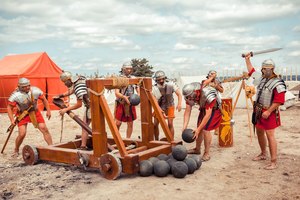Onager
The onager (lat. onagres) is an ancient Roman torsion one-armed siege engine, literally translated as a donkey (onager - an odd-toed ungulate of the horse family, a subspecies of the kulan). The onager is often incorrectly referred to as a catapult.
The onager is a simplified version of a ballista with one arm for throwing stones. The throwing lever is actuated by torsion from twisted sinews or animal hairs. A sling is attached to the other end of the lever, which increases the initial velocity of the projectile. The first mentions of the onager appear from the 4th century AD, however, archaeological finds of separate metal parts allow its appearance to be attributed to the 3rd century. The description of the machine's construction was given by the late Roman officer and historian Ammianus Marcellinus (4th century AD):
"The scorpion, which is now called the onager, has this form. Two logs are cut out of common or stone oak and slightly rounded, so that they rise humped; then they are fastened like sawhorses and drilled with large holes on both sides. Through them, strong ropes are passed, which give the machine strength so that it does not come apart. In the middle of these ropes rises at an oblique direction a wooden rod like a shaft. Ropes attached to it hold it so that it can rise upward and fall down. Iron hooks are attached to its top, on which a stump or iron sling is hung. Under this wooden structure, a thick bedding is arranged, a sheaf stuffed with crushed straw, well reinforced and laid on a pile of turf or on a platform made of brick. If you place this machine right on a stone wall, it will shake everything that is under it not because of its weight, but from a strong shake. When it comes to battle, a round stone is put in the sling, and four people on both sides of the machine quickly rotate the winding, on which the ropes are fixed, and bend the rod back, bringing it almost to a horizontal position. The artillery commander standing on top of the machine then knocks out the key with a strong blow of an iron hammer, which holds all the machine's connections. Released by a quick push, the rod deflects forward and, encountering resistance in the elastic sheaf, throws the stone, which can crush everything that comes in its way.
This machine is called a tormentum, because the tension is achieved by twisting (torquere), - a scorpion, because it has a stinging sting; recent times have given it another name, onager, because wild donkeys, being pursued in hunting, kicking back, throw such stones that they pierce the chest of their pursuers with them or, breaking the bones of the skull, crush the head."
Based on the method of throwing with a sling, it can be concluded that the trajectory of the projectile was more flat than curved. Onagers were used in the defense of fortresses or possibly as a direct-fire weapon in field combat, but in the siege of fortresses, ballistas, which shot at a high angle of elevation, were required. A contemporary of Marcellinus, the ancient Roman author Vegetius, noted that onagers were on the standard armament of a legion in the number of 10 pieces, and bulls were required for their transportation.
It is known that both stones and barrels with an incendiary mixture were thrown from onagers.
Marcellinus talked about the tactical use of onagers (or scorpions), describing the defense of the eastern fortress of Amida by the Romans from the Persians in 359 AD:
"We decided to oppose those four ballistas [installed on siege towers] with scorpions. Moving them from another place, we started with great care to install them, which requires great skill [...] From the iron slings of the scorpions with wall teeth, round stones flew at the enemy's towers. They broke the fastenings of the towers, and the ballistas along with their servants flew down, so some died from the fall, even without being wounded, others met death under the debris that fell on them."



